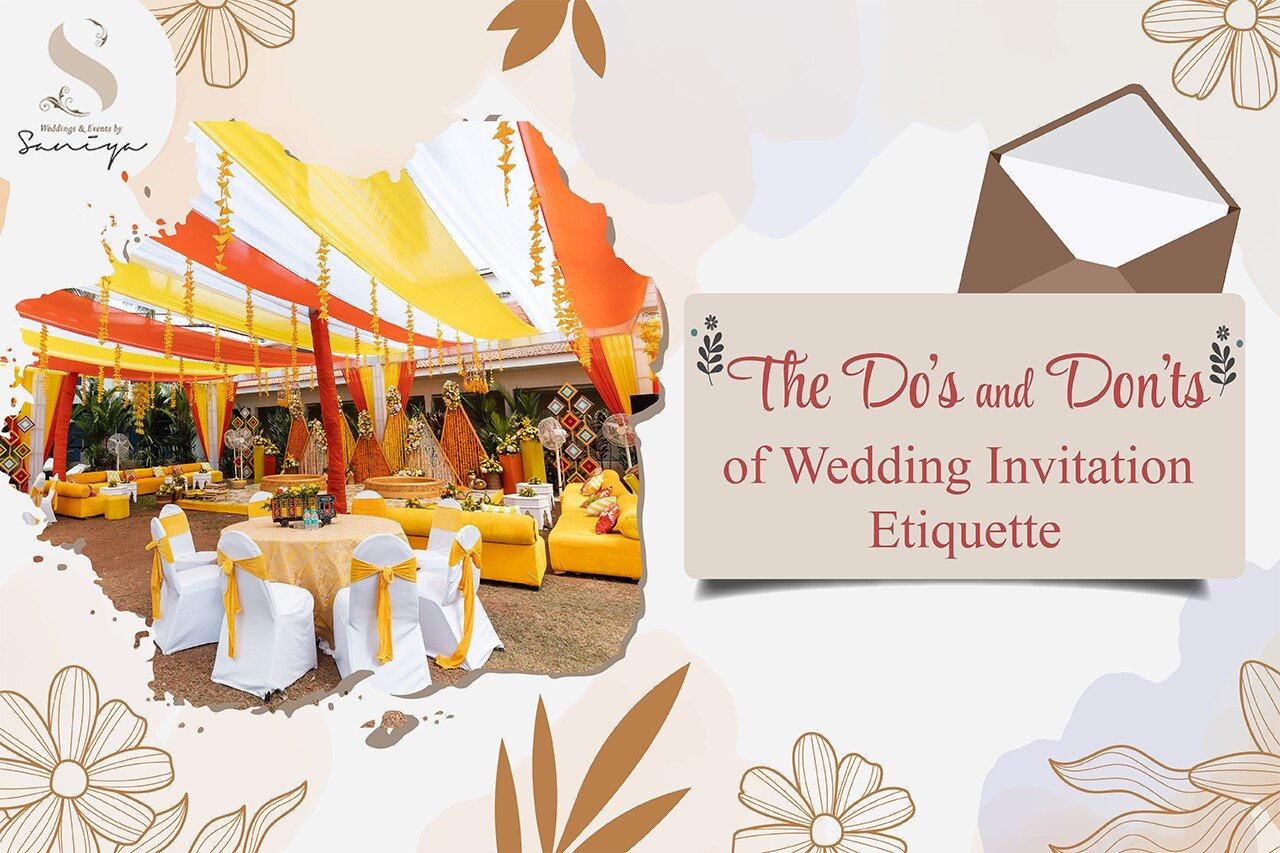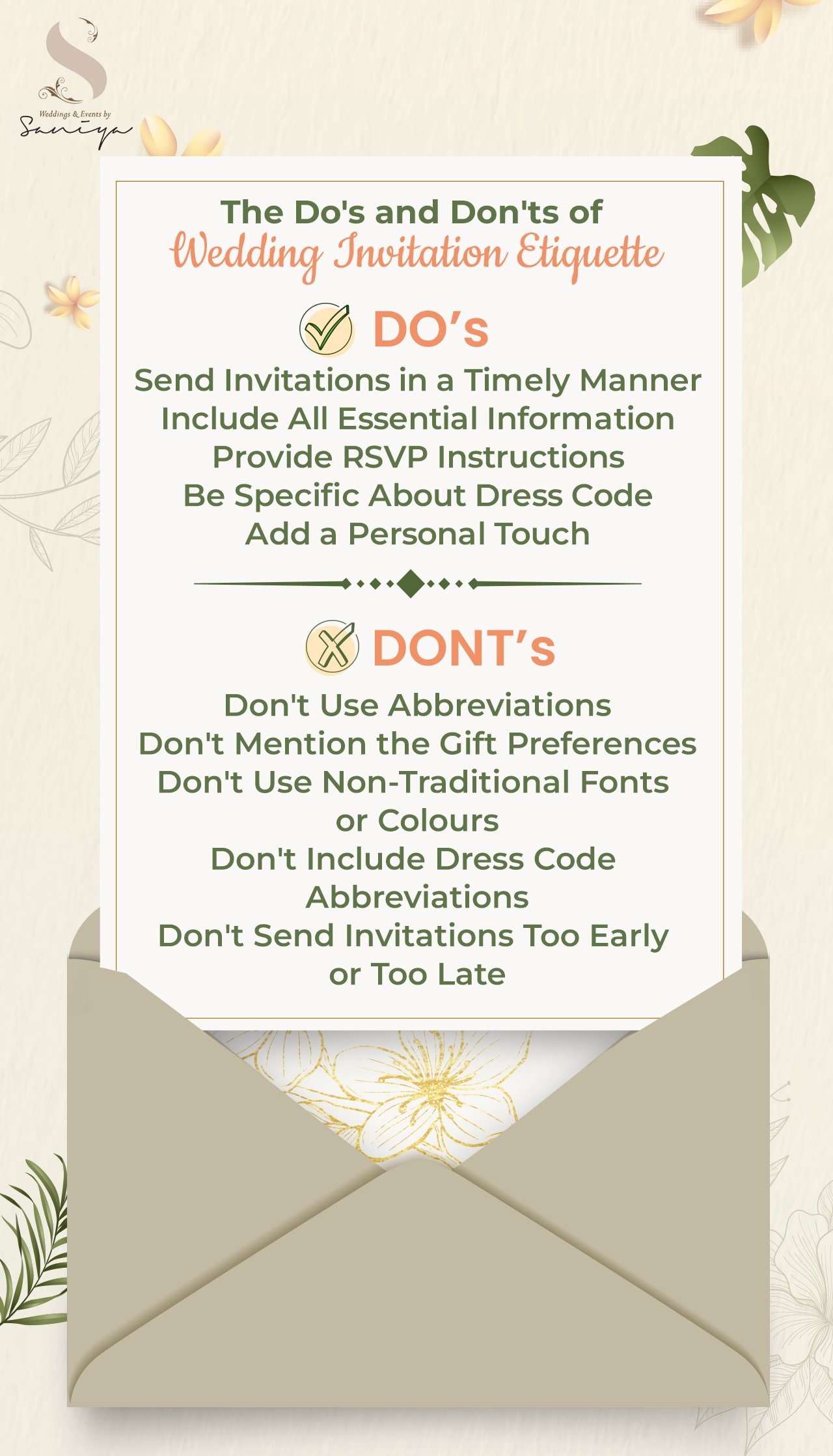
09 Aug The Do’s and Don’ts of Wedding Invitation Etiquette
Wedding invitation etiquette may make or break your wedding day, which is a once-in-a-lifetime event. Wedding invitation etiquette is one of the things that may set the tone for your big day. However, navigating wedding invitation etiquette can be both exciting and overwhelming. From addressing the envelopes to wedding invitation wording etiquette, there are several do’s and don’ts to consider to ensure that your invitations are elegant and tasteful and convey all the essential information to your guests.
In this guide, we will explore “The Do’s and Don’ts of Wedding Invitation Etiquette” to help you with wedding invitation planning and wedding invitation guidelines so that you create invitations that reflect your style while adhering to proper etiquette for wedding invitations, thereby making your guests feel honored and excited to celebrate this joyous milestone with you. Whether you’re planning a formal black-tie affair or an intimate garden wedding, this etiquette for sending out wedding invitations will ensure that your wedding invitations are a beautiful prelude to the celebration of a lifetime.
EBS, with its rich experience in providing end-to-end solutions for weddings, has the following tips to offer:

Do’s of Wedding Invitation Etiquette
The Do’s of wedding invitation etiquette is essential to ensure that your wedding invitations are elegant, clear, and considerate of your guests. Here are some things to keep in mind:
1. Invitations Sent Out on Time:
To give your guests enough time, send your wedding invitations at least six to eight weeks before the big day to allow your guests enough time to RSVP and make necessary preparations
2. Include the Relevant Information:
Include details such as the names of the hosts, the terms of the bride and groom, as well as the ceremony and reception’s date, time, and venue on your wedding invitation.
3. Use Formal Language:
Choose a formal language for traditional weddings and more casual language for contemporary or informal weddings. Keep the tone and manner constant throughout the invitation.
4. Proofread Thoroughly:
Before printing, make sure to verify and double-check all the information, including names, dates, and addresses.
5. Address Envelopes Properly:
Address the envelopes with proper titles and names of guests. Use “Mr.,” “Mrs.,” “Ms.,” or “Miss” followed by their full terms. For married couples, list their names together, and for unmarried couples, write their names on separate lines.
6. Consider Inner Envelopes:
If using inner envelopes, include the guests’ full names along with any children or additional guests invited.
7. Provide RSVP Instructions:
Indicate the RSVP date, include RSVP cards with prepaid postage, or provide other convenient methods for guests to respond.
8. Be Clear About Your Dress Code:
If your wedding has a particular dress code, specify it on the invitation so that guests can dress accordingly.
9. Include Accommodation Information:
If many guests come from out of town, include accommodation options and any group rates you’ve arranged with nearby hot
10. Be Mindful of Plus-Ones:
Only include “and guest” or “plus one” on the invitation if you invite single guests to bring a date.
11. Add a Personal Touch:
Consider adding a personal touch to your invitations, such as custom monograms, illustrations, or a heartfelt note to your guests.
Don’ts of Wedding Invitation Etiquette
EBS warns about the following pitfalls of wedding invitation etiquettes as it can impact the tone and intent of the invitation.
1. Don’t Include Registry Information:
Including registration information on the wedding invitation is considered improper. Instead, share this information through your wedding website or by word of mouth.
2. Don’t Overcrowd the Invitation:
Keep the wording concise and avoid overcrowding the invitation with excessive information. Stick to the essential details to maintain a clean and elegant look.
3. Don’t Use Abbreviations:
Avoid using abbreviations for names or other essential details on the invitation. Spell out names, locations, and additional relevant information in full.
4. Don’t Invite Guests to the Reception Only:
Inviting guests to the Reception only without including them in the ceremony is improper. If you want sure guests to attend only the Reception, consider hosting a separate celebration after the ceremony.
5. Don’t Mention the Gift Preferences:
Never mention any gift preferences or request cash gifts on the invitation. Let guests decide on their own what gift they would like to give.
6. Don’t Include RSVPs for Uninvited Guests:
Only include RSVP cards for guests specifically invited to the wedding. Do not include RSVP cards for additional guests or “plus ones” not named on the invitation.
7. Don’t Forget to Proofread:
Avoid any embarrassing mistakes by thoroughly proofreading the invitation before sending it out. Check for spelling, grammar, and formatting errors.
8. Don’t Use Non-Traditional Fonts or Colors:
Stick to legible and easy-to-read fonts. Avoid applying too many distinct fonts or colors, making the invitation appear filled and difficult to read.
9. Don’t Send Invitations Too Early or Too Late:
Sending invitations too far in advance can lead to guests forgetting about the event, while sending them too late may not give guests enough time to plan their attendance.
10. Don’t Include Dress Code Abbreviations:
Instead of using abbreviations like “black tie” or “cocktail attire,” use proper wording like “Formal Attire” or “Cocktail Attire” to specify the dress code.
11. Don’t Use Email Invitations for Formal Weddings:
Email invitations are more suitable for informal events. For a formal wedding, opt for traditional printed invitations.
To Summarize
Wedding etiquette is a set of social customs and guidelines that have evolved to ensure that weddings are conducted with grace, respect, and consideration for all parties involved. At the heart of wedding etiquette is respect and courtesy towards guests, family, and friends. By acting correctly, you convey that you value and welcome their presence. This creates a feeling of comfort and belonging, making everyone feel cherished and welcomed.
Etiquette helps set the tone for your wedding, conveying the formality or informality of the event. Similarly, clear and thoughtful communication through invitations and other wedding interactions helps avoid awkward situations and misunderstandings. A well-planned wedding with attention to etiquette ensures guest comfort. E.g., Providing accommodation information, offering vegetarian or dietary options, and making thoughtful arrangements for elderly or differently-abled guests show your consideration and care for their well-being. Etiquette allows you to incorporate your values and cultural traditions into the wedding.
Would you pass over proper wedding etiquette and miss to create an atmosphere of respect and kindness and set the stage for a memorable and meaningful celebration?
Frequently Asked Questions
Q1. What is the etiquette for names on wedding invitations?
The etiquette for names on wedding invitations follows traditional norms. The hosts’ names or the couple’s parents are typically mentioned initially, followed by the couple getting married. The bride’s name is usually listed before the groom’s name. If the wedding couple hosts the wedding themselves, their names are listed as the hosts. For more formal invitations, full names are used, including titles such as “Mr.,” “Mrs.,” or “Dr.,” while for less formal invitations, first names can be used.
Q2. Why does a wedding invitation have the woman’s name first?
Traditionally, the woman’s name is listed first on a wedding invitation as a sign of respect and honor to the bride and her family. It is a customary practice with historical roots, symbolizing the bride’s prominence in the event. Modern wedding invitations, on the other hand, can list the names in any sequence that feels acceptable to the couple.
Q3. Does the bride’s last name go on the invitation?
The bride’s first and last names are typically in traditional wedding invitations. For example, “Ms. Jane Smith.” However, in contemporary invitations, couples may consist of only the bride’s or both partners’ first names, depending on their preferences and the event’s formality.
Q4. How does an invitation start?
A wedding invitation typically starts with the names of the hosts or the couple’s parents, followed by an invitation line that requests the guest’s presence at the wedding. The bride and groom’s names are then written down, along with the day, date, time, and venue of the wedding ceremony and celebration.The invitation could also specify the RSVP, a place to stay and a dress code.
Q5. What is the whole meaning of the invite?
The meaning of “invite” is to extend a formal request for someone’s presence or participation in an event or occasion. When you invite someone, you invite them to be a part of a specific gathering or activity, indicating their presence is welcomed and desired. In the context of a wedding, sending out invitations is a way to formally request guests’ attendance on the couple’s special day.
